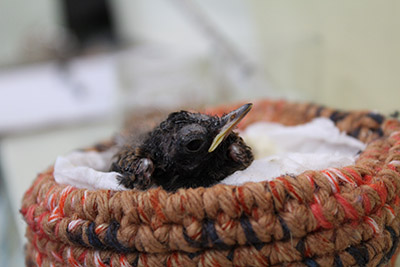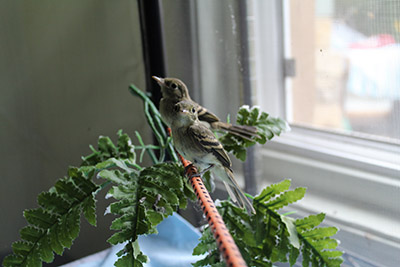Flycatcher Care at CWC: A Journey to Freedom
By Senior Wildlife Technician, Cambria Wells
Upon intake at CWC, baby birds range widely in age, health, and more. A critical task within their first few hours of admission is identifying their species, to begin to provide them with the appropriate care. Los Angeles is home to 518 species of native birds, many of which are especially similar in appearance while in their juvenile feathers. Even more are nearly identical in the first couple weeks of life; their featherless skin and underdeveloped bodies at this age may look very different from how we see them as young adults in our yards and parks.

Black Phoebe Nestling
Most important to very young birds are their housing and dietary needs. Many flycatchers make “cup” nests which we mimic in our hospital; crocheted nests made and donated to CWC are placed into incubators for the youngest birds or those needing a little extra heat support. Older birds are housed in front of sunny windows in small enclosures with appropriate perching and leafy cover for their comfort. They are then hand fed whole insects at thirty- or forty-five-minute intervals by the OCU’s dedicated team of volunteers. How we achieve good nutrition depends on species; for some birds there is a commercial formula which we can use to suit their needs. Some require a homemade mix or blended formula of whole food items and vitamins. For birds on formula, this diet includes all their nutritional needs. For insectivores like our Pacific-slope Flycatchers, who receive a whole prey diet, we give special vitamins by mouth daily and pay close attention to the balance of their diet. Even the insects we feed them are carefully prepared by “gut-loading” with nutritious foods. This ensures our patients build strong bones, smooth well-structured feathers, and the appropriate colors to appear indistinguishable from their wild-raised cousins.

Pacific Slope Flycatcher Fledglings
Though complex, raising baby birds and witnessing their growth into strong, independent, and unique patients is the greatest reward of working in our Orphan Care Unit. Volunteers and staff often remark that they never noticed a species near their home or when hiking until getting to know them at CWC; then, they see and hear them everywhere! Growing our skills in identifying and observing these birds in the wild and at CWC builds an incredibly rewarding relationship. It’s always good to get to know your neighbors.
